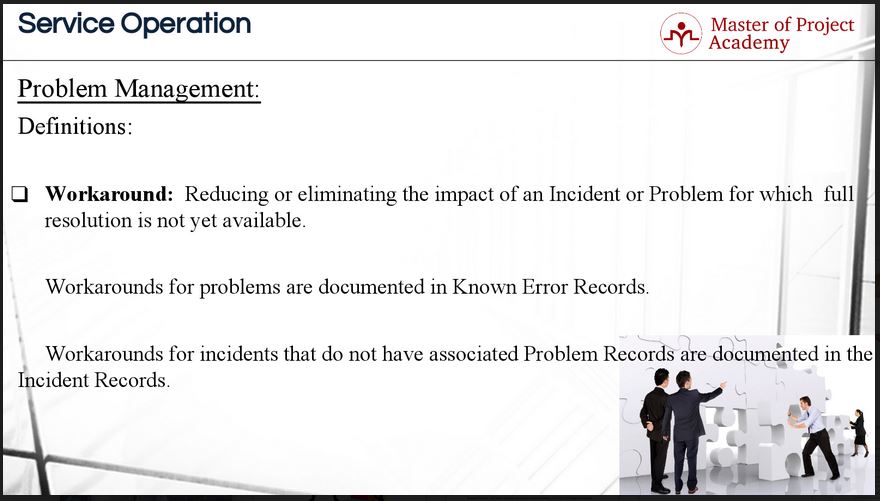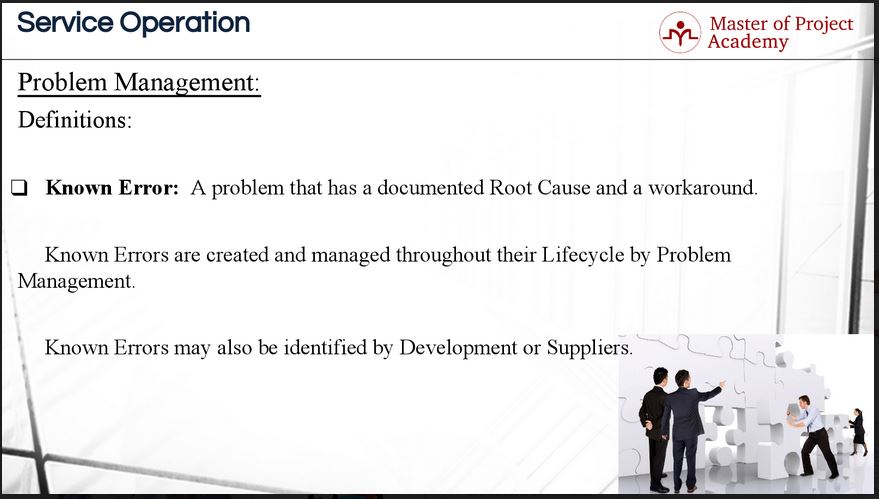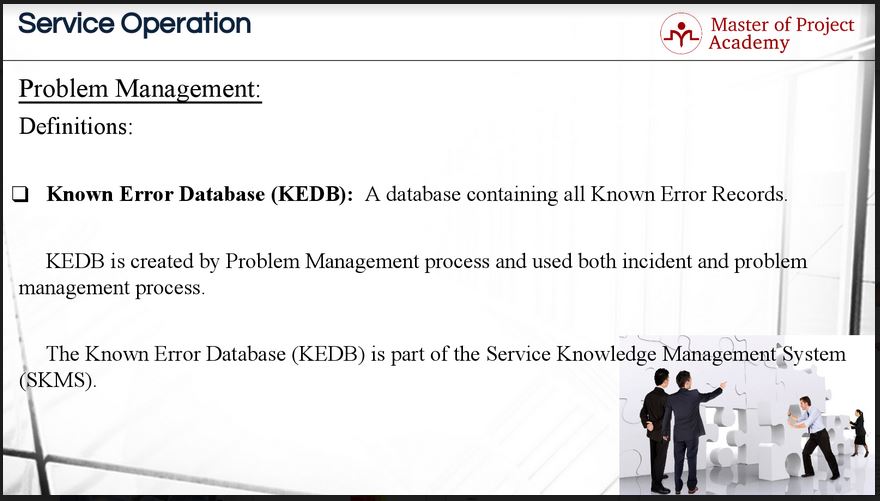The problem management process is one of the primary processes of the ITIL Service Operation stage of the ITIL lifecycle. To be able to apply the principles of the problem management process, it is necessary to be familiar with all the key terms that are relevant to the process. The terms are defined in ITIL foundation training where the problem management process is discussed. Online free ITIL training is a useful way to familiarize yourself with all the ITIL terms and definitions. We’ll help you today by tackling 4 key terms of the process management process.
Here are 4 important problem management process terms and their definitions that you need to know.

Problem management process term 1: Problem
In the problem management process, a problem is defined as the cause of one or more incidents. So there is a cause and effect relationship between an incident and a problem. The cause is the problem and the effect is the incident. For instance, a user reports that he cannot use a service. This is the incident. When this is reported, you don’t know the cause of the problem why the user cannot use the service. After analysis and investigation, you found that there was an overload on the application server and this caused some users to be unable to use the service. And this is the problem – the server could not suffice the required demand for the service. Finding the problem is part of the problem management process.

Therefore, the cause is not usually known at the time a problem record is created, and the problem management process is responsible for further investigation. After the incident is logged, the relevant department or parties deal with the incident to find the problem. After the problem has been identified the team works together to fix the problem using the problem management process steps.
Problem management process term 2: Workaround
In the problem management process, a workaround is defined as reducing or eliminating the impact of an incident or problem for which a full resolution is not yet available. For instance, let’s consider a service is stuck after operating for more than a week in an IT service provider and does not respond to customer requests properly. But if this service is restarted, then it starts to work properly for a week again. Restarting the service is a workaround for this problem because the root cause which causes the service to get stuck is not found but restarting the service fix the problem for a period of time. This is one way of dealing with problems in the problem management process.

Workarounds for problems are documented in known error records, another dimension of the problem management process. Until a permanent fix is found and applied to a problem, workarounds will be applied to reduce the impacts of the problem. The relevant actions of the workaround must be applied whenever the problem reoccurs. Therefore, the steps needed to apply the workaround for a problem is documented in the known error records as part of the problem management process.
Workarounds for incidents that do not have associated problem records are documented in the incident records. So, if there is an incident, but the problem causing this incident is not yet identified since there is not any problem yet, these incidents are documented in the incident records.
Problem management process term 3: Known Error
A known error is a problem that has a documented root cause and a workaround. Let’s consider that an application server cannot serve one hundred thousand users as planned. This is an incident because some of the users are affected by service delivery quality. After an investigation, it is found that the root cause of the problem is that the disk of the application server creates a system log and unnecessary system files in six hours even it is cleaned. The IT service provider has developed a workaround for this problem and a system administrator checks the disk usage every hour, and whenever it exceeds ninety percent, the administrator cleans the system logs and unnecessary files manually.
This is an example of a known error, root cause, and workaround respectively.
Known errors are created and managed throughout their lifecycle by the problem management process. Incidents are turned into problems if the root cause is identified. If there is a fix for the problem, it is applied immediately. But if there is not a permanent solution yet but there is a workaround, it is recorded to fix the problem temporarily. And this is managed by the problem management process.

Known errors may also be identified by the development team or suppliers. Let’s consider that an IT service provider is having problems with the services acquired from the suppliers. If the supplier cannot provide a permanent solution, it can offer a workaround as well.
Problem management process term 4: Known Error Database
The known error database in problem management process is abbreviated as KEDB and it is a database containing all known error records. There can be several services, configuration items and known errors of assets in an IT Service provider. And a problem can be faced by or affect another department or party in an IT service provider. Or even a different customer can contact the service desk and report the same known error.
In order to store all known errors and provide immediate workarounds for the identified problems whenever they reoccur, the known error database is created by the problem management process and used both by incident management process and problem management process together. So if a user is reporting an incident which is already known, the staff will search the known error database and find the workaround for the problem and apply it as part of the problem management process. The known error database is part of the service knowledge management system as well because it is a database that helps to store information about known errors of service assets in an IT service provider.

Being familiar with the terms that apply to the problem management process is an important step towards the correct application of this important ITIL process. The problem management process is a key process that is used to successfully apply the Service Operation stage of the ITIL service lifecycle.
Review by: Tyler Snyder
